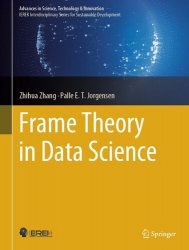Frame Theory in Data Science
- Добавил: literator
- Дата: 15-04-2024, 17:20
- Комментариев: 0
 Название: Frame Theory in Data Science
Название: Frame Theory in Data ScienceАвтор: Zhihua Zhang, Palle E.T. Jorgensen
Издательство: Springer
Год: 2024
Страниц: 262
Язык: английский
Формат: pdf (true), epub
Размер: 39.3 MB
This book establishes brand-new frame theory and technical implementation in Data Science, with a special focus on spatial-scale feature extraction, network dynamics, object-oriented analysis, data-driven environmental prediction, and climate diagnosis. Given that Data Science is unanimously recognized as a core driver for achieving Sustainable Development Goals of the United Nations, these frame techniques bring fundamental changes to multi-channel data mining systems and support the development of digital Earth platforms. This book integrates the authors' frame research in the past twenty years and provides cutting-edge techniques and depth for scientists, professionals, and graduate students in Data Science, applied mathematics, environmental science, and geoscience.
In this book, we have established the theory of Dirac frames, polynomial frames, quasiorthogonal frames, periodic frames, and frame trees, and characterized adaptive segmentation of data spectral domain by quasi-orthogonal and pseudo-project frame operators. Since these frame techniques can represent any local data information over frame (tree) elements living in different spatial-scale cells in the overlapping or non-overlapping spectral manners, it will bring fundamental changes to multi-channel data mining systems: more spatial-scale channels are assigned dynamically and adaptively to the position where abrupt changes occur, narrow-band noise can be automatically deleted by directly assigning them to special channels, sufficient robustness and redundancy are conserved within channels, and sufficient independence are conserved among channels.
As an emerging branch of statistical and Deep Learning, frame networks can automatically acquire novel knowledge from observation data through a statistical learning process and then makes reliable predictions and downscaling. A frame network consists of three layers: the input layer, the hidden layer, and the output layer, where various frames are embedded into each node of the hidden layer and frame coefficients are used as the weight of the directed edges from one node to another node. Frame networks provide a unique nonlinear tool for simulation, downscaling, and prediction in the mining of Big Data. Different from frame networks, frames on networks deal with dynamical system living on complex networks and provide novel insights into topological and dynamical features of complex nonlinear systems over a wide range of spatial/temporal scales.
Скачать Frame Theory in Data Science
Внимание
Уважаемый посетитель, Вы зашли на сайт как незарегистрированный пользователь.
Мы рекомендуем Вам зарегистрироваться либо войти на сайт под своим именем.
Уважаемый посетитель, Вы зашли на сайт как незарегистрированный пользователь.
Мы рекомендуем Вам зарегистрироваться либо войти на сайт под своим именем.
Информация
Посетители, находящиеся в группе Гости, не могут оставлять комментарии к данной публикации.
Посетители, находящиеся в группе Гости, не могут оставлять комментарии к данной публикации.
